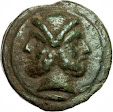Roman Steelyard Balance
1st-3rd century AD
I
bought an interesting, and small, Roman Steelyard scale in a recent auction. It
was advertised as bronze. It is not magnetic, so I assume bronze is correct.
The length of the beam is 150 mm. The seller advertised it as 240 mm. It is 240
mm if you hold the scale by the weighing hook, but it is impossible to weigh
items that way. “A steelyard has a beam with unequal arms. The long arm has a
weight suspended from it, which is moved until equilibrium is obtained. The
load is suspended from the short arm of the beam.1” This scale has two
fulcrum points, or weight ranges (low and high). Weight range is switched by
rotating the load hook 180o and using the other fulcrum point.
The
scale is good but not the best design available in ancient Rome. Scale accuracy
is a function of repeatable distances between the fulcrum hanger, load hanger
and weight hanger. The most accurate design had load and fulcrum points in the
center of the scale arm and used football shaped dowels, see pics below of my small
steelyard scale and two different 19th century scales.
The
weight range of this scale is indicated by stamped dots or lines on two sides
of the scale arm. I could not make a regular pattern on either side. The low
weight range scale arm had 14 dots and two lines. The high weight scale arm had
only two dots (that I could see for sure) and about 8 lines (again hard to
see). In a flat part of the scale arm were several counter stamps. I assume the
stamps were some approval of the scale’s calibration. They are hard to see in
hand or in pictures, but I guess there are a dozen or more. The counter stamps
are not all the same. One looks a bit like PacMan with a wide open mouth.
This
scale is a plane jane version. Some scales have decorations. I thought this one
might be decorated because the seller mentioned a finial. A finial is an
ornament at the top, end, or corner of an object. See pic below.
I
am not sure what would have been measured with a scale this size, but I
estimate the max weight would be about 6 US pounds or 3 Kg. I bent the holder of
a scale when I attempted to put too much weight (3 asses, or 3 US pounds,
including both the weights and some Aes Rude) on a two pan balance about this
size.
The
seller’s description, modified a bit:
Roman
Steelyard Balance. 1st-3rd century AD
A
bronze steelyard with impressed point scale, two lateral chains and finial with
hook, lead weight with wire hook. 29 grams total, steelyard: 24cm overall (9
1/2"). Note: the overall length is only 150 mm! The extra 90 mm is when
the chain and hook are counted as length.
[2
pieces: scale & scale weight]
Condition:
Fine condition.
Provenance:
Private collection, home counties, UK; acquired before 1980.
TimeLine
Auctions; September 4 to 10, 2018: Ancient Art, Antiquities & Coins; LOT
1217
Scale
Weight = 26.38 grams
Weight
Dia = 17.8 – 18.2 mm
Weight
height = 16.2 mm (56 mm including hook)
Scale beam length
15.6
mm from short arm fulcrum to short end
135
mm from short arm fulcrum to long end
150
mm total length
High range scale, short distance
from fulcrum hanger to hook for holding item to be weighed
15
mm from short arm fulcrum to weight hook (high weight scale)
135
mm from short arm fulcrum to long end
27
mm from short arm fulcrum to minimum weigh point of long end
Ratio
= 135 / 15 = 9.0
Ratio
= 27 / 15 = 1.8
Low range scale, long distance
from fulcrum hanger to hook for holding item to be weighed
28.9
mm from long arm fulcrum to weight hook (low weight scale)
123
mm from long arm fulcrum to long end
27
mm from long arm fulcrum to minimum weigh point of long end
Ratio
= 123 / 28.9 = 4.3
Ratio
= 13 / 28.9 = 0.45
|
Scale Range
|
Minimum,
with one uncia weight that came with scale
|
Maximum,
with one uncia weight that came with scale
|
Minimum,
with one As weight
|
Maximum,
with one As weight
|
|
Low, long arm
|
0.45
uncia = 12 g
|
4.3
uncia = 120 g
|
0.45
As = 150 g
|
4.3
As = 1,400 g
|
|
High, short arm
|
1.8
uncia = 49 g
|
9.0
uncia = 250 g
|
1.8
As = 590 g
|
9.0
As = 2,900 g
|
|
|
|
|
|
|
scale in high weight range mode
scale in low weight mode, note the scale weight is just the right weight to balance the scale, some scales place a plumb bob on the scale to help detect the balance point
19th century scale
19th century scale
counter marks on side one
counter marks on side two
finial ornament at the top of an Islamic mosque
measuring scale arm
References:
7.
Measuring
and weighing in ancient Times, English editor – A. M. Goldstein, Hecht Museum
8.
Pondera,
Pesi E Misure Nell’Antichita; Carla Corti & Nicolette Giordani


















































